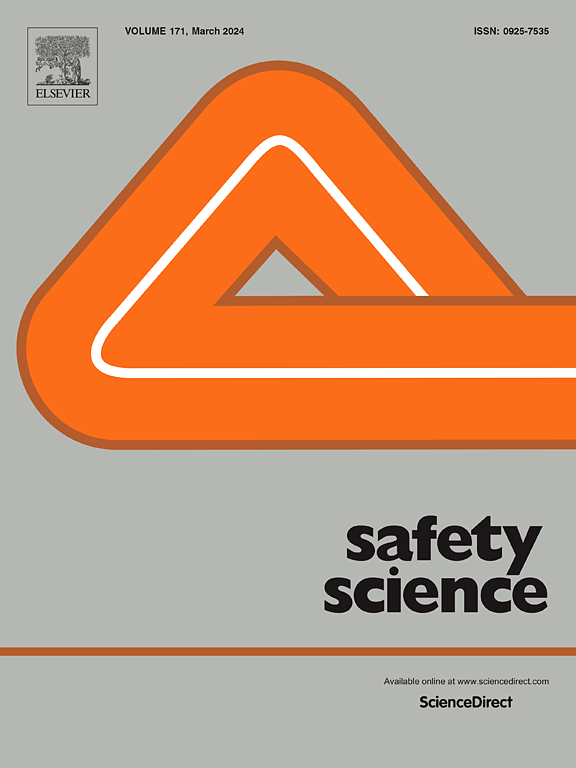Exploring the mediating role of competence in cyclist safety and comfort: A visuo-haptic virtual reality (VR) study☆
IF 4.7
1区 工程技术
Q1 ENGINEERING, INDUSTRIAL
引用次数: 0
Abstract
Background
Cyclist safety and comfort are essential for encouraging urban cycling. Virtual reality (VR) technologies provide a controlled yet immersive environment to explore these factors, making it an innovative approach to safety research.
Objectives
The objective is to investigate the relationships between perceived safety, comfort, and competence and how external factors such as bikeway characteristics, traffic conditions, environmental conditions, and individual factors influence these perceptions.
Methods
(i) Participants: 212 cyclists from Tehran participated in the experiment. (ii) Apparatus: A visuo-haptic VR cycling simulator was used. It integrated visual and haptic sensory inputs and included environmental simulations. (iii) Procedure: Each participant cycled through multiple urban routes in the VR cycling simulator, where they navigated a series of virtual streets and intersections. These scenarios varied in cycling facility designs (i.e., bikeway types, bikeway continuity, and marking and signals), traffic characteristics (i.e., cyclist volume, vehicular traffic volume, and vehicular speed limitation), and environmental conditions (i.e., daytime and weather conditions). A number of 20 scenarios were defined. (iv) Modeling: Structural equation modeling (SEM) was applied to analyze the relationships between observed factors and perceived safety, comfort, and competence.
Findings
Cold-rainy weather has the most significant negative effect on both safety and comfort perceptions, both directly and indirectly, through reduced competence. Bikeway type strongly influences these perceptions, with those on the sidewalk consistently rated highest for safety and comfort. Other factors, including bike lane continuity, traffic volume, speed limitation, signaling and marking, and cyclist demographics, also play roles of varying importance.
能力在骑行者安全与舒适中的中介作用:一项视觉-触觉虚拟现实(VR)研究☆
骑行者的安全和舒适对于鼓励城市骑行至关重要。虚拟现实(VR)技术为探索这些因素提供了一个可控的沉浸式环境,使其成为安全研究的一种创新方法。目的研究感知安全、舒适和能力之间的关系,以及外部因素如自行车道特征、交通状况、环境条件和个人因素如何影响这些感知。方法(i)参与者:来自德黑兰的212名骑自行车的人参加了实验。(ii)设备:使用视触觉VR骑行模拟器。它集成了视觉和触觉感官输入,并包括环境模拟。(iii)程序:每个参与者在VR骑行模拟器中骑行多条城市路线,在虚拟街道和十字路口进行导航。这些场景在自行车设施设计(即自行车道类型、自行车道连续性、标志和信号)、交通特征(即骑自行车者数量、车辆交通量和车辆速度限制)和环境条件(即白天和天气条件)方面各不相同。定义了20个场景。(iv)建模:采用结构方程模型(SEM)分析观察因素与感知安全、舒适和能力之间的关系。研究发现,阴冷多雨的天气直接或间接地降低了员工的工作能力,对员工的安全感和舒适度都有显著的负面影响。自行车道的类型强烈地影响着这些看法,人行道上的自行车在安全性和舒适性方面一直被评为最高。其他因素,包括自行车道连续性、交通量、速度限制、信号和标记以及骑自行车的人口统计数据,也发挥着不同的重要作用。
本文章由计算机程序翻译,如有差异,请以英文原文为准。
求助全文
约1分钟内获得全文
求助全文
来源期刊

Safety Science
管理科学-工程:工业
CiteScore
13.00
自引率
9.80%
发文量
335
审稿时长
53 days
期刊介绍:
Safety Science is multidisciplinary. Its contributors and its audience range from social scientists to engineers. The journal covers the physics and engineering of safety; its social, policy and organizational aspects; the assessment, management and communication of risks; the effectiveness of control and management techniques for safety; standardization, legislation, inspection, insurance, costing aspects, human behavior and safety and the like. Papers addressing the interfaces between technology, people and organizations are especially welcome.
 求助内容:
求助内容: 应助结果提醒方式:
应助结果提醒方式:


